Sales and Selling Report: Sales Techniques, Structures, and Strategies
VerifiedAdded on 2022/08/08
|14
|3599
|23
Report
AI Summary
This report delves into the critical aspects of sales and selling within the context of a handcrafted accessories business. It begins with an executive summary outlining the importance of sales techniques and strategies for business success. The report then explores industry trends in the handmade fashion market, emphasizing the increasing demand for handcrafted items. It identifies key principles and techniques of successful selling, such as building relationships, focusing on customer problems, and understanding the value proposition. The report further analyzes the concept of selling through others, evaluating its applicability to the business. A critical analysis of how these principles and techniques contribute to building and managing customer relationships is provided. The report evaluates various sales structures relevant to the product range and assesses the implementation of different sales structures, illustrating with organizational examples. It explains sales strategies for maximizing profitability within a defined sales structure, and it concludes by evaluating and recommending an efficient sales structure to improve financial viability and strategic advantage over competitors. The report provides a comprehensive overview of sales strategies, structures, and techniques essential for the success of the handcrafted accessories business.

Running head: SALES AND SELLING
SALES AND SELLING
Task 2
Name of the Student
Name of the University
Author Note
SALES AND SELLING
Task 2
Name of the Student
Name of the University
Author Note
Secure Best Marks with AI Grader
Need help grading? Try our AI Grader for instant feedback on your assignments.
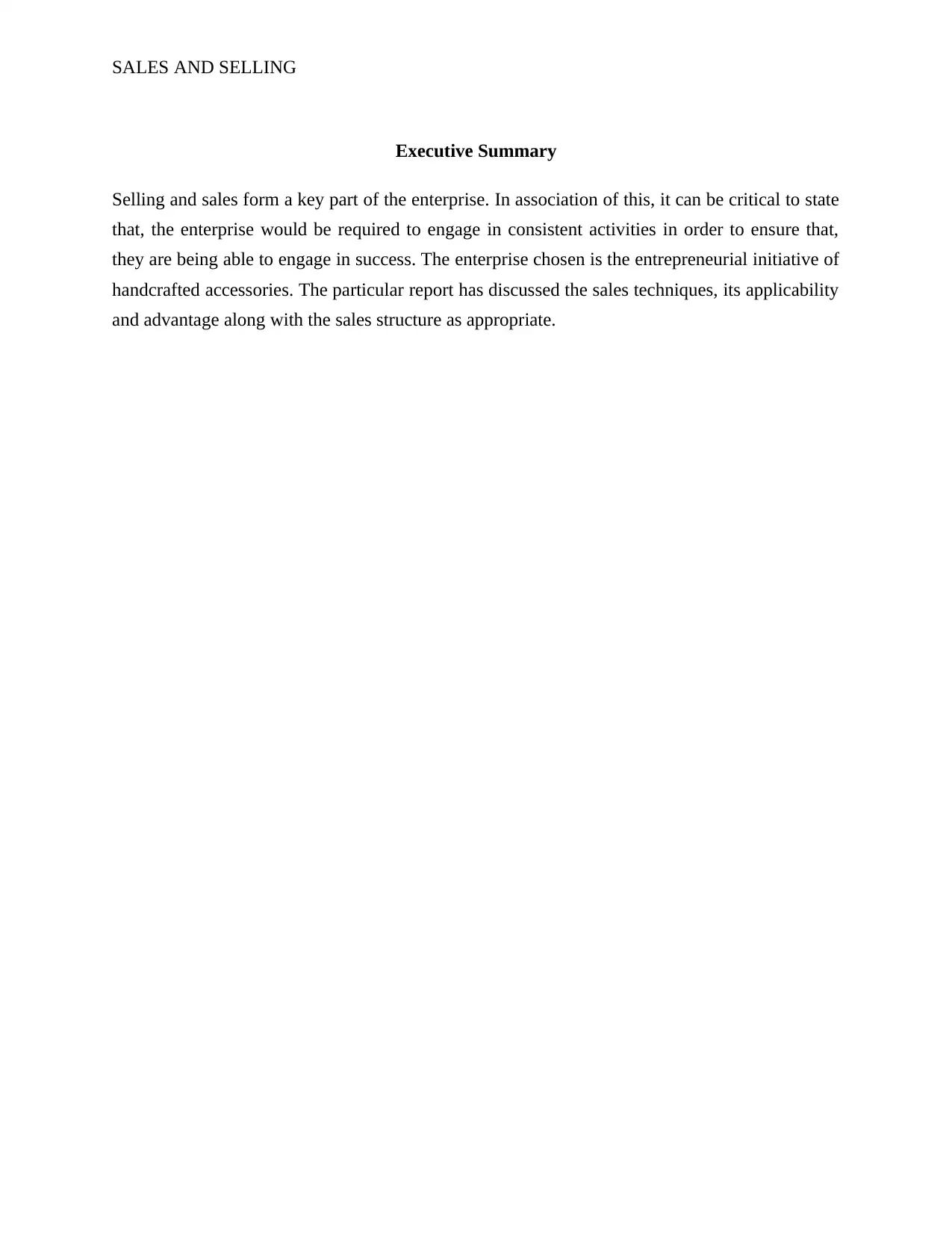
SALES AND SELLING
Executive Summary
Selling and sales form a key part of the enterprise. In association of this, it can be critical to state
that, the enterprise would be required to engage in consistent activities in order to ensure that,
they are being able to engage in success. The enterprise chosen is the entrepreneurial initiative of
handcrafted accessories. The particular report has discussed the sales techniques, its applicability
and advantage along with the sales structure as appropriate.
Executive Summary
Selling and sales form a key part of the enterprise. In association of this, it can be critical to state
that, the enterprise would be required to engage in consistent activities in order to ensure that,
they are being able to engage in success. The enterprise chosen is the entrepreneurial initiative of
handcrafted accessories. The particular report has discussed the sales techniques, its applicability
and advantage along with the sales structure as appropriate.
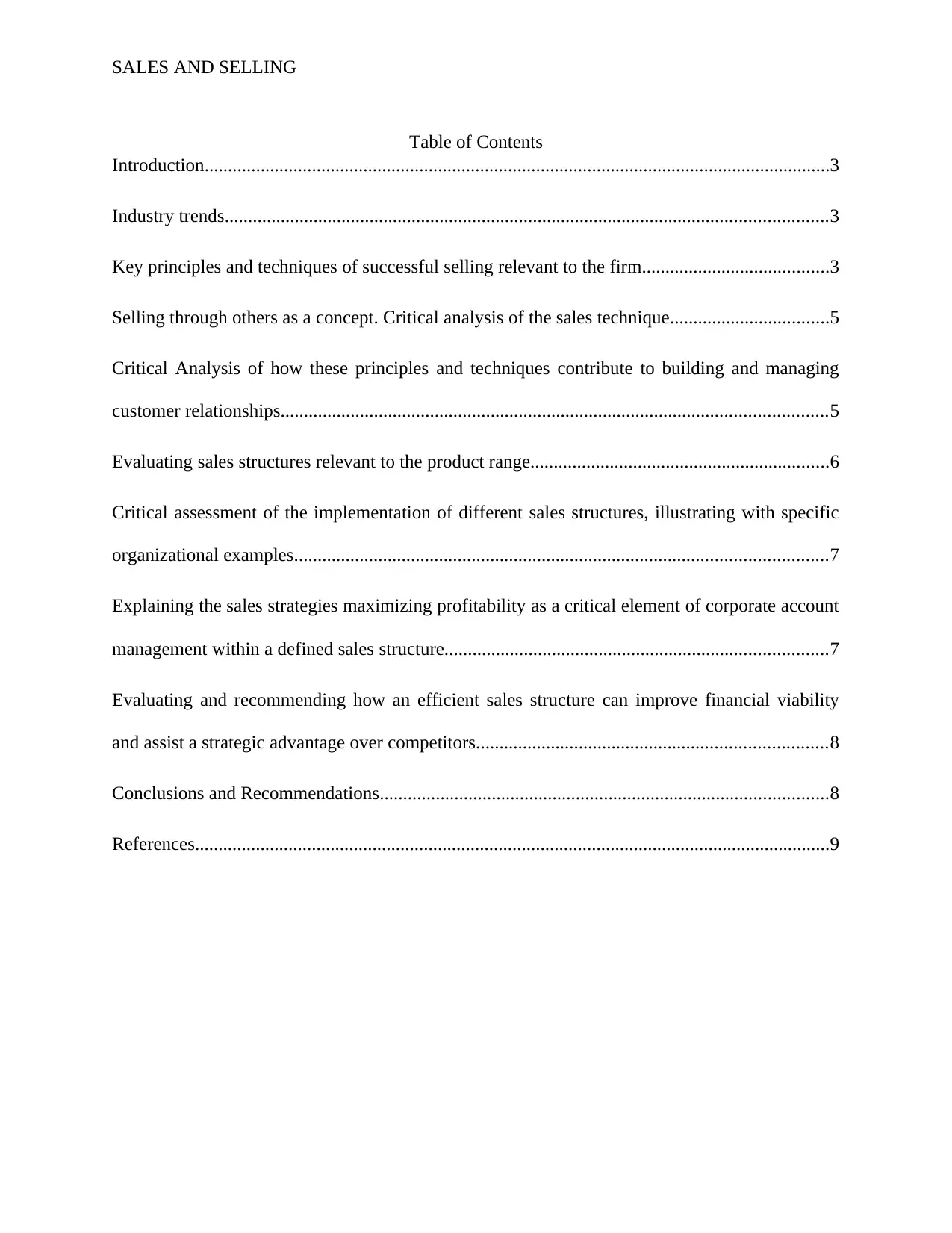
SALES AND SELLING
Table of Contents
Introduction......................................................................................................................................3
Industry trends.................................................................................................................................3
Key principles and techniques of successful selling relevant to the firm........................................3
Selling through others as a concept. Critical analysis of the sales technique..................................5
Critical Analysis of how these principles and techniques contribute to building and managing
customer relationships.....................................................................................................................5
Evaluating sales structures relevant to the product range................................................................6
Critical assessment of the implementation of different sales structures, illustrating with specific
organizational examples..................................................................................................................7
Explaining the sales strategies maximizing profitability as a critical element of corporate account
management within a defined sales structure..................................................................................7
Evaluating and recommending how an efficient sales structure can improve financial viability
and assist a strategic advantage over competitors...........................................................................8
Conclusions and Recommendations................................................................................................8
References........................................................................................................................................9
Table of Contents
Introduction......................................................................................................................................3
Industry trends.................................................................................................................................3
Key principles and techniques of successful selling relevant to the firm........................................3
Selling through others as a concept. Critical analysis of the sales technique..................................5
Critical Analysis of how these principles and techniques contribute to building and managing
customer relationships.....................................................................................................................5
Evaluating sales structures relevant to the product range................................................................6
Critical assessment of the implementation of different sales structures, illustrating with specific
organizational examples..................................................................................................................7
Explaining the sales strategies maximizing profitability as a critical element of corporate account
management within a defined sales structure..................................................................................7
Evaluating and recommending how an efficient sales structure can improve financial viability
and assist a strategic advantage over competitors...........................................................................8
Conclusions and Recommendations................................................................................................8
References........................................................................................................................................9
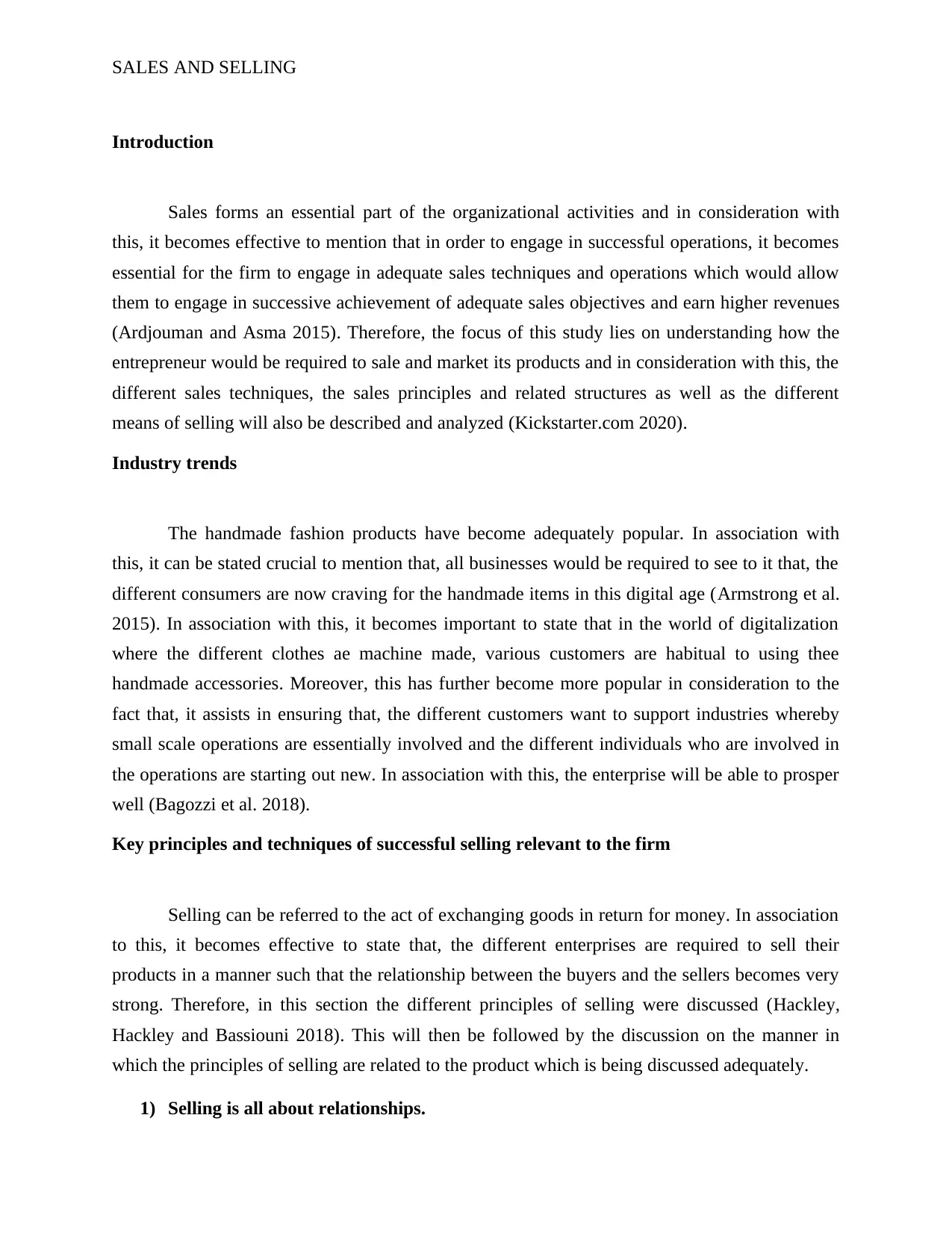
SALES AND SELLING
Introduction
Sales forms an essential part of the organizational activities and in consideration with
this, it becomes effective to mention that in order to engage in successful operations, it becomes
essential for the firm to engage in adequate sales techniques and operations which would allow
them to engage in successive achievement of adequate sales objectives and earn higher revenues
(Ardjouman and Asma 2015). Therefore, the focus of this study lies on understanding how the
entrepreneur would be required to sale and market its products and in consideration with this, the
different sales techniques, the sales principles and related structures as well as the different
means of selling will also be described and analyzed (Kickstarter.com 2020).
Industry trends
The handmade fashion products have become adequately popular. In association with
this, it can be stated crucial to mention that, all businesses would be required to see to it that, the
different consumers are now craving for the handmade items in this digital age (Armstrong et al.
2015). In association with this, it becomes important to state that in the world of digitalization
where the different clothes ae machine made, various customers are habitual to using thee
handmade accessories. Moreover, this has further become more popular in consideration to the
fact that, it assists in ensuring that, the different customers want to support industries whereby
small scale operations are essentially involved and the different individuals who are involved in
the operations are starting out new. In association with this, the enterprise will be able to prosper
well (Bagozzi et al. 2018).
Key principles and techniques of successful selling relevant to the firm
Selling can be referred to the act of exchanging goods in return for money. In association
to this, it becomes effective to state that, the different enterprises are required to sell their
products in a manner such that the relationship between the buyers and the sellers becomes very
strong. Therefore, in this section the different principles of selling were discussed (Hackley,
Hackley and Bassiouni 2018). This will then be followed by the discussion on the manner in
which the principles of selling are related to the product which is being discussed adequately.
1) Selling is all about relationships.
Introduction
Sales forms an essential part of the organizational activities and in consideration with
this, it becomes effective to mention that in order to engage in successful operations, it becomes
essential for the firm to engage in adequate sales techniques and operations which would allow
them to engage in successive achievement of adequate sales objectives and earn higher revenues
(Ardjouman and Asma 2015). Therefore, the focus of this study lies on understanding how the
entrepreneur would be required to sale and market its products and in consideration with this, the
different sales techniques, the sales principles and related structures as well as the different
means of selling will also be described and analyzed (Kickstarter.com 2020).
Industry trends
The handmade fashion products have become adequately popular. In association with
this, it can be stated crucial to mention that, all businesses would be required to see to it that, the
different consumers are now craving for the handmade items in this digital age (Armstrong et al.
2015). In association with this, it becomes important to state that in the world of digitalization
where the different clothes ae machine made, various customers are habitual to using thee
handmade accessories. Moreover, this has further become more popular in consideration to the
fact that, it assists in ensuring that, the different customers want to support industries whereby
small scale operations are essentially involved and the different individuals who are involved in
the operations are starting out new. In association with this, the enterprise will be able to prosper
well (Bagozzi et al. 2018).
Key principles and techniques of successful selling relevant to the firm
Selling can be referred to the act of exchanging goods in return for money. In association
to this, it becomes effective to state that, the different enterprises are required to sell their
products in a manner such that the relationship between the buyers and the sellers becomes very
strong. Therefore, in this section the different principles of selling were discussed (Hackley,
Hackley and Bassiouni 2018). This will then be followed by the discussion on the manner in
which the principles of selling are related to the product which is being discussed adequately.
1) Selling is all about relationships.
Secure Best Marks with AI Grader
Need help grading? Try our AI Grader for instant feedback on your assignments.
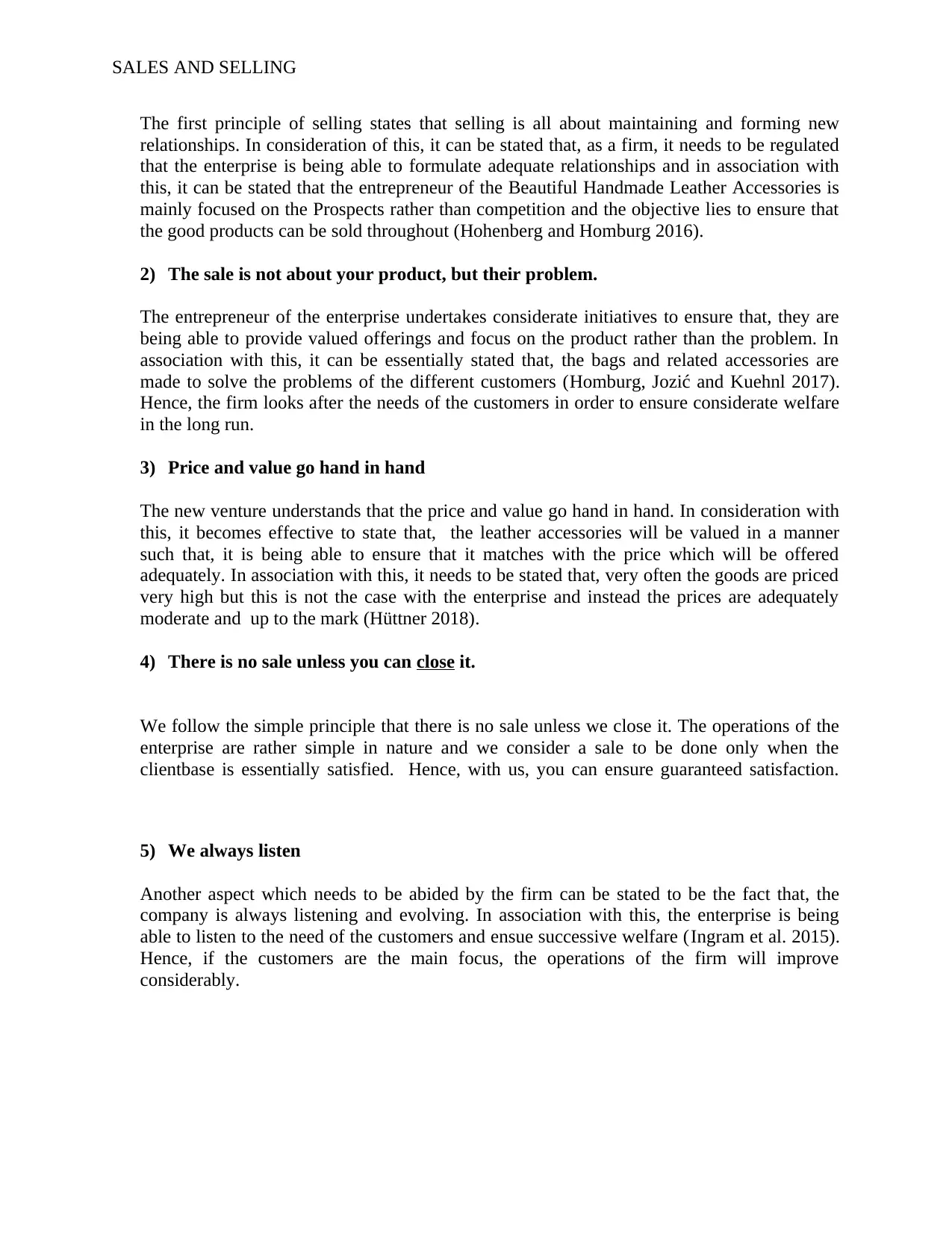
SALES AND SELLING
The first principle of selling states that selling is all about maintaining and forming new
relationships. In consideration of this, it can be stated that, as a firm, it needs to be regulated
that the enterprise is being able to formulate adequate relationships and in association with
this, it can be stated that the entrepreneur of the Beautiful Handmade Leather Accessories is
mainly focused on the Prospects rather than competition and the objective lies to ensure that
the good products can be sold throughout (Hohenberg and Homburg 2016).
2) The sale is not about your product, but their problem.
The entrepreneur of the enterprise undertakes considerate initiatives to ensure that, they are
being able to provide valued offerings and focus on the product rather than the problem. In
association with this, it can be essentially stated that, the bags and related accessories are
made to solve the problems of the different customers (Homburg, Jozić and Kuehnl 2017).
Hence, the firm looks after the needs of the customers in order to ensure considerate welfare
in the long run.
3) Price and value go hand in hand
The new venture understands that the price and value go hand in hand. In consideration with
this, it becomes effective to state that, the leather accessories will be valued in a manner
such that, it is being able to ensure that it matches with the price which will be offered
adequately. In association with this, it needs to be stated that, very often the goods are priced
very high but this is not the case with the enterprise and instead the prices are adequately
moderate and up to the mark (Hüttner 2018).
4) There is no sale unless you can close it.
We follow the simple principle that there is no sale unless we close it. The operations of the
enterprise are rather simple in nature and we consider a sale to be done only when the
clientbase is essentially satisfied. Hence, with us, you can ensure guaranteed satisfaction.
5) We always listen
Another aspect which needs to be abided by the firm can be stated to be the fact that, the
company is always listening and evolving. In association with this, the enterprise is being
able to listen to the need of the customers and ensue successive welfare (Ingram et al. 2015).
Hence, if the customers are the main focus, the operations of the firm will improve
considerably.
The first principle of selling states that selling is all about maintaining and forming new
relationships. In consideration of this, it can be stated that, as a firm, it needs to be regulated
that the enterprise is being able to formulate adequate relationships and in association with
this, it can be stated that the entrepreneur of the Beautiful Handmade Leather Accessories is
mainly focused on the Prospects rather than competition and the objective lies to ensure that
the good products can be sold throughout (Hohenberg and Homburg 2016).
2) The sale is not about your product, but their problem.
The entrepreneur of the enterprise undertakes considerate initiatives to ensure that, they are
being able to provide valued offerings and focus on the product rather than the problem. In
association with this, it can be essentially stated that, the bags and related accessories are
made to solve the problems of the different customers (Homburg, Jozić and Kuehnl 2017).
Hence, the firm looks after the needs of the customers in order to ensure considerate welfare
in the long run.
3) Price and value go hand in hand
The new venture understands that the price and value go hand in hand. In consideration with
this, it becomes effective to state that, the leather accessories will be valued in a manner
such that, it is being able to ensure that it matches with the price which will be offered
adequately. In association with this, it needs to be stated that, very often the goods are priced
very high but this is not the case with the enterprise and instead the prices are adequately
moderate and up to the mark (Hüttner 2018).
4) There is no sale unless you can close it.
We follow the simple principle that there is no sale unless we close it. The operations of the
enterprise are rather simple in nature and we consider a sale to be done only when the
clientbase is essentially satisfied. Hence, with us, you can ensure guaranteed satisfaction.
5) We always listen
Another aspect which needs to be abided by the firm can be stated to be the fact that, the
company is always listening and evolving. In association with this, the enterprise is being
able to listen to the need of the customers and ensue successive welfare (Ingram et al. 2015).
Hence, if the customers are the main focus, the operations of the firm will improve
considerably.
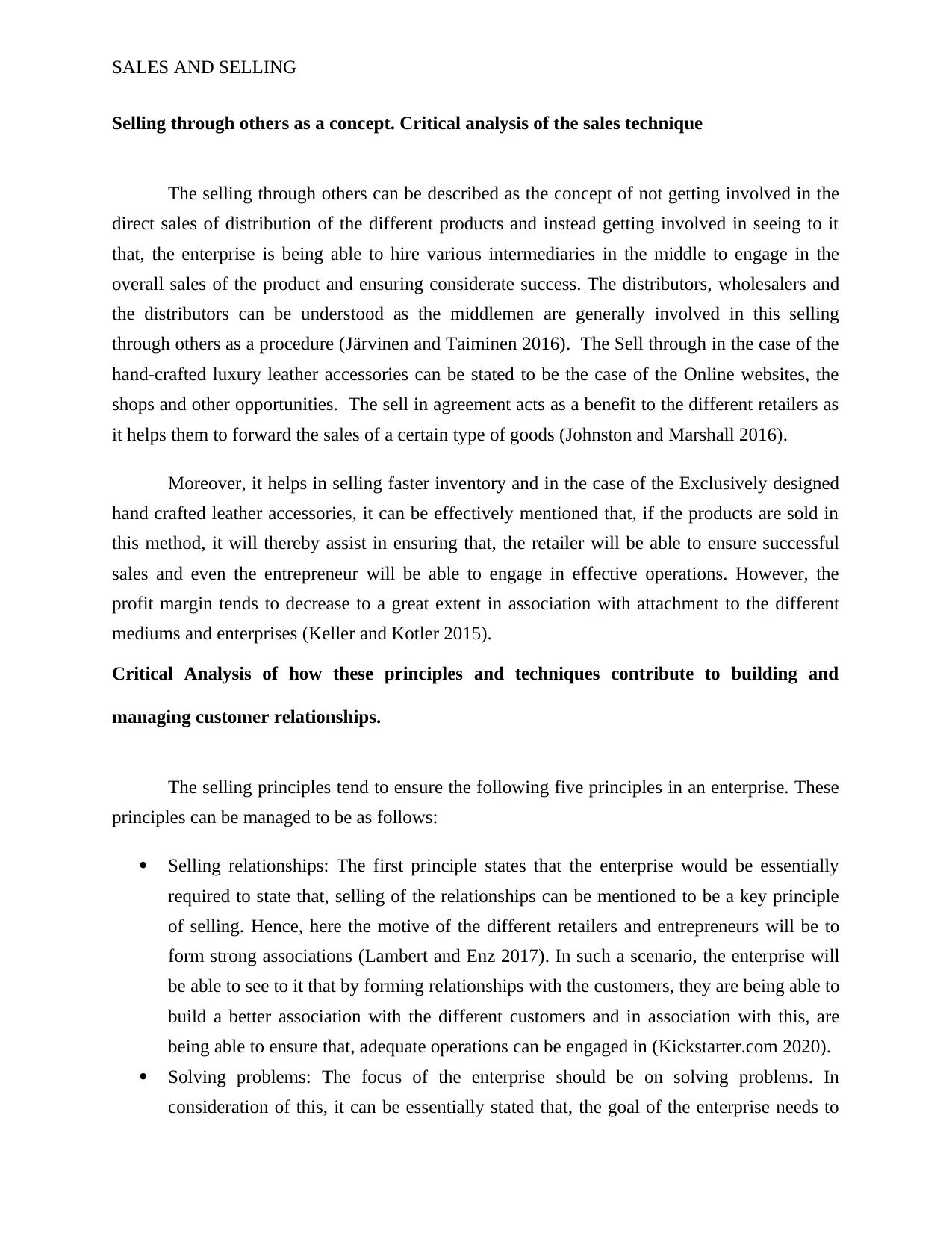
SALES AND SELLING
Selling through others as a concept. Critical analysis of the sales technique
The selling through others can be described as the concept of not getting involved in the
direct sales of distribution of the different products and instead getting involved in seeing to it
that, the enterprise is being able to hire various intermediaries in the middle to engage in the
overall sales of the product and ensuring considerate success. The distributors, wholesalers and
the distributors can be understood as the middlemen are generally involved in this selling
through others as a procedure (Järvinen and Taiminen 2016). The Sell through in the case of the
hand-crafted luxury leather accessories can be stated to be the case of the Online websites, the
shops and other opportunities. The sell in agreement acts as a benefit to the different retailers as
it helps them to forward the sales of a certain type of goods (Johnston and Marshall 2016).
Moreover, it helps in selling faster inventory and in the case of the Exclusively designed
hand crafted leather accessories, it can be effectively mentioned that, if the products are sold in
this method, it will thereby assist in ensuring that, the retailer will be able to ensure successful
sales and even the entrepreneur will be able to engage in effective operations. However, the
profit margin tends to decrease to a great extent in association with attachment to the different
mediums and enterprises (Keller and Kotler 2015).
Critical Analysis of how these principles and techniques contribute to building and
managing customer relationships.
The selling principles tend to ensure the following five principles in an enterprise. These
principles can be managed to be as follows:
Selling relationships: The first principle states that the enterprise would be essentially
required to state that, selling of the relationships can be mentioned to be a key principle
of selling. Hence, here the motive of the different retailers and entrepreneurs will be to
form strong associations (Lambert and Enz 2017). In such a scenario, the enterprise will
be able to see to it that by forming relationships with the customers, they are being able to
build a better association with the different customers and in association with this, are
being able to ensure that, adequate operations can be engaged in (Kickstarter.com 2020).
Solving problems: The focus of the enterprise should be on solving problems. In
consideration of this, it can be essentially stated that, the goal of the enterprise needs to
Selling through others as a concept. Critical analysis of the sales technique
The selling through others can be described as the concept of not getting involved in the
direct sales of distribution of the different products and instead getting involved in seeing to it
that, the enterprise is being able to hire various intermediaries in the middle to engage in the
overall sales of the product and ensuring considerate success. The distributors, wholesalers and
the distributors can be understood as the middlemen are generally involved in this selling
through others as a procedure (Järvinen and Taiminen 2016). The Sell through in the case of the
hand-crafted luxury leather accessories can be stated to be the case of the Online websites, the
shops and other opportunities. The sell in agreement acts as a benefit to the different retailers as
it helps them to forward the sales of a certain type of goods (Johnston and Marshall 2016).
Moreover, it helps in selling faster inventory and in the case of the Exclusively designed
hand crafted leather accessories, it can be effectively mentioned that, if the products are sold in
this method, it will thereby assist in ensuring that, the retailer will be able to ensure successful
sales and even the entrepreneur will be able to engage in effective operations. However, the
profit margin tends to decrease to a great extent in association with attachment to the different
mediums and enterprises (Keller and Kotler 2015).
Critical Analysis of how these principles and techniques contribute to building and
managing customer relationships.
The selling principles tend to ensure the following five principles in an enterprise. These
principles can be managed to be as follows:
Selling relationships: The first principle states that the enterprise would be essentially
required to state that, selling of the relationships can be mentioned to be a key principle
of selling. Hence, here the motive of the different retailers and entrepreneurs will be to
form strong associations (Lambert and Enz 2017). In such a scenario, the enterprise will
be able to see to it that by forming relationships with the customers, they are being able to
build a better association with the different customers and in association with this, are
being able to ensure that, adequate operations can be engaged in (Kickstarter.com 2020).
Solving problems: The focus of the enterprise should be on solving problems. In
consideration of this, it can be essentially stated that, the goal of the enterprise needs to
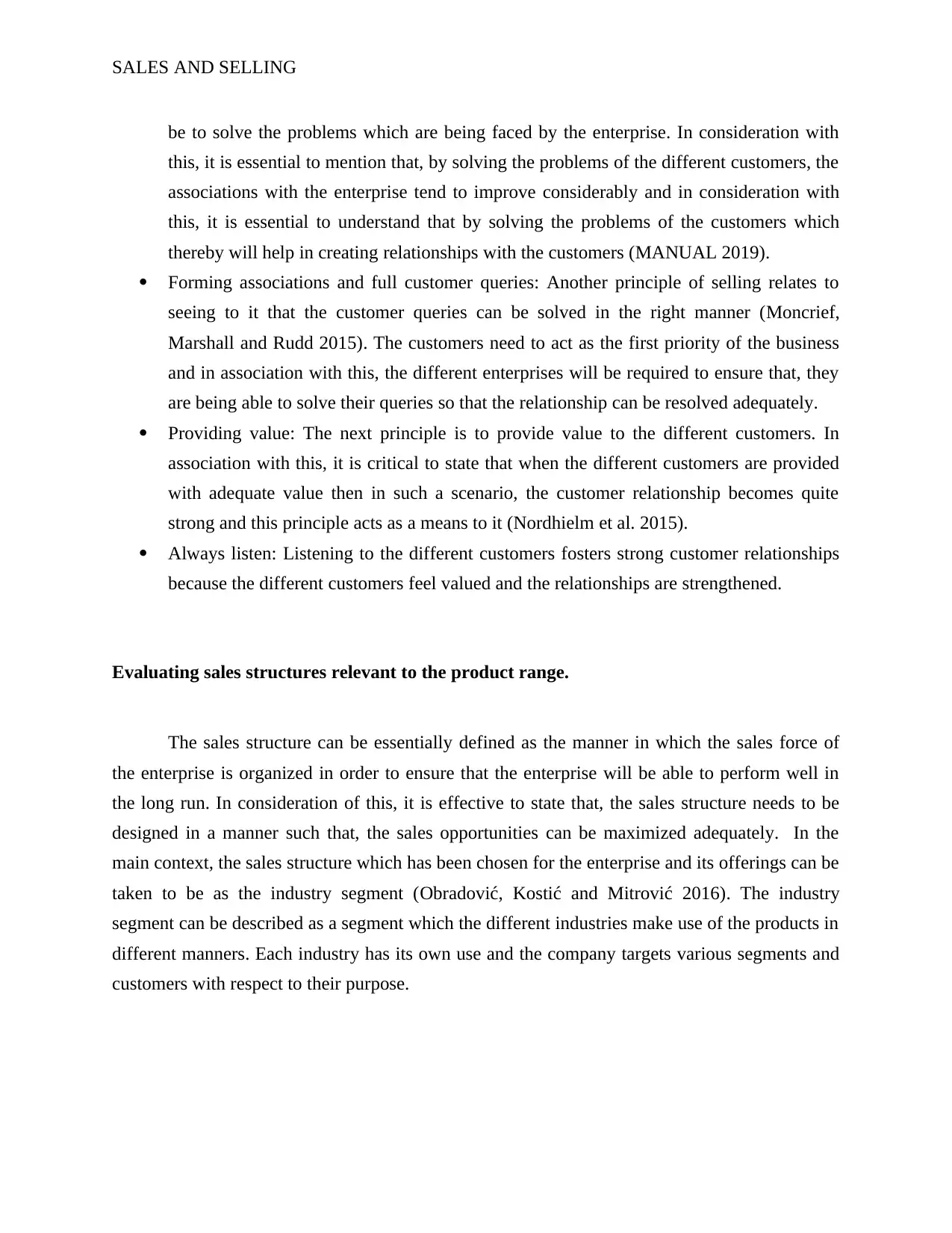
SALES AND SELLING
be to solve the problems which are being faced by the enterprise. In consideration with
this, it is essential to mention that, by solving the problems of the different customers, the
associations with the enterprise tend to improve considerably and in consideration with
this, it is essential to understand that by solving the problems of the customers which
thereby will help in creating relationships with the customers (MANUAL 2019).
Forming associations and full customer queries: Another principle of selling relates to
seeing to it that the customer queries can be solved in the right manner (Moncrief,
Marshall and Rudd 2015). The customers need to act as the first priority of the business
and in association with this, the different enterprises will be required to ensure that, they
are being able to solve their queries so that the relationship can be resolved adequately.
Providing value: The next principle is to provide value to the different customers. In
association with this, it is critical to state that when the different customers are provided
with adequate value then in such a scenario, the customer relationship becomes quite
strong and this principle acts as a means to it (Nordhielm et al. 2015).
Always listen: Listening to the different customers fosters strong customer relationships
because the different customers feel valued and the relationships are strengthened.
Evaluating sales structures relevant to the product range.
The sales structure can be essentially defined as the manner in which the sales force of
the enterprise is organized in order to ensure that the enterprise will be able to perform well in
the long run. In consideration of this, it is effective to state that, the sales structure needs to be
designed in a manner such that, the sales opportunities can be maximized adequately. In the
main context, the sales structure which has been chosen for the enterprise and its offerings can be
taken to be as the industry segment (Obradović, Kostić and Mitrović 2016). The industry
segment can be described as a segment which the different industries make use of the products in
different manners. Each industry has its own use and the company targets various segments and
customers with respect to their purpose.
be to solve the problems which are being faced by the enterprise. In consideration with
this, it is essential to mention that, by solving the problems of the different customers, the
associations with the enterprise tend to improve considerably and in consideration with
this, it is essential to understand that by solving the problems of the customers which
thereby will help in creating relationships with the customers (MANUAL 2019).
Forming associations and full customer queries: Another principle of selling relates to
seeing to it that the customer queries can be solved in the right manner (Moncrief,
Marshall and Rudd 2015). The customers need to act as the first priority of the business
and in association with this, the different enterprises will be required to ensure that, they
are being able to solve their queries so that the relationship can be resolved adequately.
Providing value: The next principle is to provide value to the different customers. In
association with this, it is critical to state that when the different customers are provided
with adequate value then in such a scenario, the customer relationship becomes quite
strong and this principle acts as a means to it (Nordhielm et al. 2015).
Always listen: Listening to the different customers fosters strong customer relationships
because the different customers feel valued and the relationships are strengthened.
Evaluating sales structures relevant to the product range.
The sales structure can be essentially defined as the manner in which the sales force of
the enterprise is organized in order to ensure that the enterprise will be able to perform well in
the long run. In consideration of this, it is effective to state that, the sales structure needs to be
designed in a manner such that, the sales opportunities can be maximized adequately. In the
main context, the sales structure which has been chosen for the enterprise and its offerings can be
taken to be as the industry segment (Obradović, Kostić and Mitrović 2016). The industry
segment can be described as a segment which the different industries make use of the products in
different manners. Each industry has its own use and the company targets various segments and
customers with respect to their purpose.
Paraphrase This Document
Need a fresh take? Get an instant paraphrase of this document with our AI Paraphraser
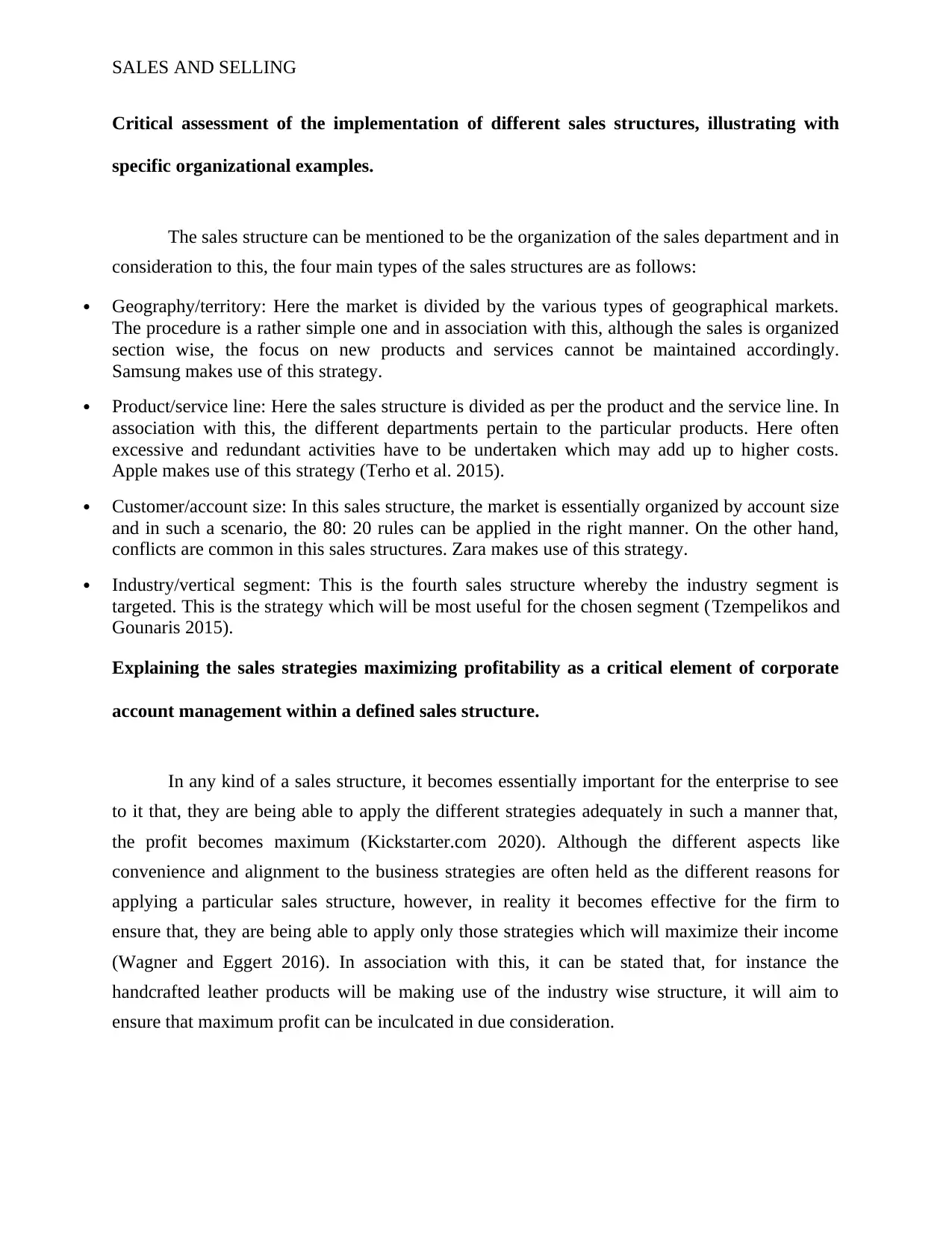
SALES AND SELLING
Critical assessment of the implementation of different sales structures, illustrating with
specific organizational examples.
The sales structure can be mentioned to be the organization of the sales department and in
consideration to this, the four main types of the sales structures are as follows:
Geography/territory: Here the market is divided by the various types of geographical markets.
The procedure is a rather simple one and in association with this, although the sales is organized
section wise, the focus on new products and services cannot be maintained accordingly.
Samsung makes use of this strategy.
Product/service line: Here the sales structure is divided as per the product and the service line. In
association with this, the different departments pertain to the particular products. Here often
excessive and redundant activities have to be undertaken which may add up to higher costs.
Apple makes use of this strategy (Terho et al. 2015).
Customer/account size: In this sales structure, the market is essentially organized by account size
and in such a scenario, the 80: 20 rules can be applied in the right manner. On the other hand,
conflicts are common in this sales structures. Zara makes use of this strategy.
Industry/vertical segment: This is the fourth sales structure whereby the industry segment is
targeted. This is the strategy which will be most useful for the chosen segment (Tzempelikos and
Gounaris 2015).
Explaining the sales strategies maximizing profitability as a critical element of corporate
account management within a defined sales structure.
In any kind of a sales structure, it becomes essentially important for the enterprise to see
to it that, they are being able to apply the different strategies adequately in such a manner that,
the profit becomes maximum (Kickstarter.com 2020). Although the different aspects like
convenience and alignment to the business strategies are often held as the different reasons for
applying a particular sales structure, however, in reality it becomes effective for the firm to
ensure that, they are being able to apply only those strategies which will maximize their income
(Wagner and Eggert 2016). In association with this, it can be stated that, for instance the
handcrafted leather products will be making use of the industry wise structure, it will aim to
ensure that maximum profit can be inculcated in due consideration.
Critical assessment of the implementation of different sales structures, illustrating with
specific organizational examples.
The sales structure can be mentioned to be the organization of the sales department and in
consideration to this, the four main types of the sales structures are as follows:
Geography/territory: Here the market is divided by the various types of geographical markets.
The procedure is a rather simple one and in association with this, although the sales is organized
section wise, the focus on new products and services cannot be maintained accordingly.
Samsung makes use of this strategy.
Product/service line: Here the sales structure is divided as per the product and the service line. In
association with this, the different departments pertain to the particular products. Here often
excessive and redundant activities have to be undertaken which may add up to higher costs.
Apple makes use of this strategy (Terho et al. 2015).
Customer/account size: In this sales structure, the market is essentially organized by account size
and in such a scenario, the 80: 20 rules can be applied in the right manner. On the other hand,
conflicts are common in this sales structures. Zara makes use of this strategy.
Industry/vertical segment: This is the fourth sales structure whereby the industry segment is
targeted. This is the strategy which will be most useful for the chosen segment (Tzempelikos and
Gounaris 2015).
Explaining the sales strategies maximizing profitability as a critical element of corporate
account management within a defined sales structure.
In any kind of a sales structure, it becomes essentially important for the enterprise to see
to it that, they are being able to apply the different strategies adequately in such a manner that,
the profit becomes maximum (Kickstarter.com 2020). Although the different aspects like
convenience and alignment to the business strategies are often held as the different reasons for
applying a particular sales structure, however, in reality it becomes effective for the firm to
ensure that, they are being able to apply only those strategies which will maximize their income
(Wagner and Eggert 2016). In association with this, it can be stated that, for instance the
handcrafted leather products will be making use of the industry wise structure, it will aim to
ensure that maximum profit can be inculcated in due consideration.
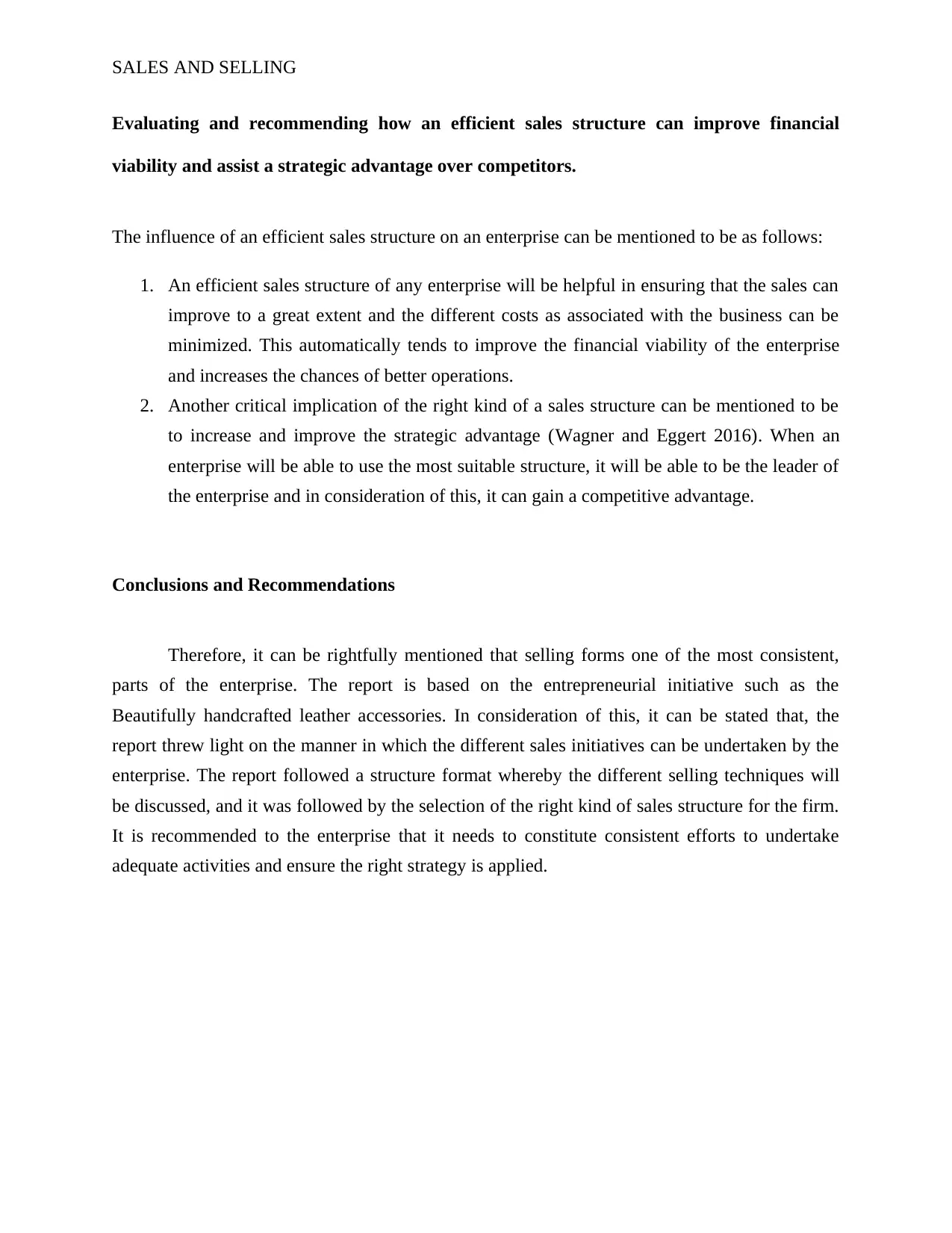
SALES AND SELLING
Evaluating and recommending how an efficient sales structure can improve financial
viability and assist a strategic advantage over competitors.
The influence of an efficient sales structure on an enterprise can be mentioned to be as follows:
1. An efficient sales structure of any enterprise will be helpful in ensuring that the sales can
improve to a great extent and the different costs as associated with the business can be
minimized. This automatically tends to improve the financial viability of the enterprise
and increases the chances of better operations.
2. Another critical implication of the right kind of a sales structure can be mentioned to be
to increase and improve the strategic advantage (Wagner and Eggert 2016). When an
enterprise will be able to use the most suitable structure, it will be able to be the leader of
the enterprise and in consideration of this, it can gain a competitive advantage.
Conclusions and Recommendations
Therefore, it can be rightfully mentioned that selling forms one of the most consistent,
parts of the enterprise. The report is based on the entrepreneurial initiative such as the
Beautifully handcrafted leather accessories. In consideration of this, it can be stated that, the
report threw light on the manner in which the different sales initiatives can be undertaken by the
enterprise. The report followed a structure format whereby the different selling techniques will
be discussed, and it was followed by the selection of the right kind of sales structure for the firm.
It is recommended to the enterprise that it needs to constitute consistent efforts to undertake
adequate activities and ensure the right strategy is applied.
Evaluating and recommending how an efficient sales structure can improve financial
viability and assist a strategic advantage over competitors.
The influence of an efficient sales structure on an enterprise can be mentioned to be as follows:
1. An efficient sales structure of any enterprise will be helpful in ensuring that the sales can
improve to a great extent and the different costs as associated with the business can be
minimized. This automatically tends to improve the financial viability of the enterprise
and increases the chances of better operations.
2. Another critical implication of the right kind of a sales structure can be mentioned to be
to increase and improve the strategic advantage (Wagner and Eggert 2016). When an
enterprise will be able to use the most suitable structure, it will be able to be the leader of
the enterprise and in consideration of this, it can gain a competitive advantage.
Conclusions and Recommendations
Therefore, it can be rightfully mentioned that selling forms one of the most consistent,
parts of the enterprise. The report is based on the entrepreneurial initiative such as the
Beautifully handcrafted leather accessories. In consideration of this, it can be stated that, the
report threw light on the manner in which the different sales initiatives can be undertaken by the
enterprise. The report followed a structure format whereby the different selling techniques will
be discussed, and it was followed by the selection of the right kind of sales structure for the firm.
It is recommended to the enterprise that it needs to constitute consistent efforts to undertake
adequate activities and ensure the right strategy is applied.
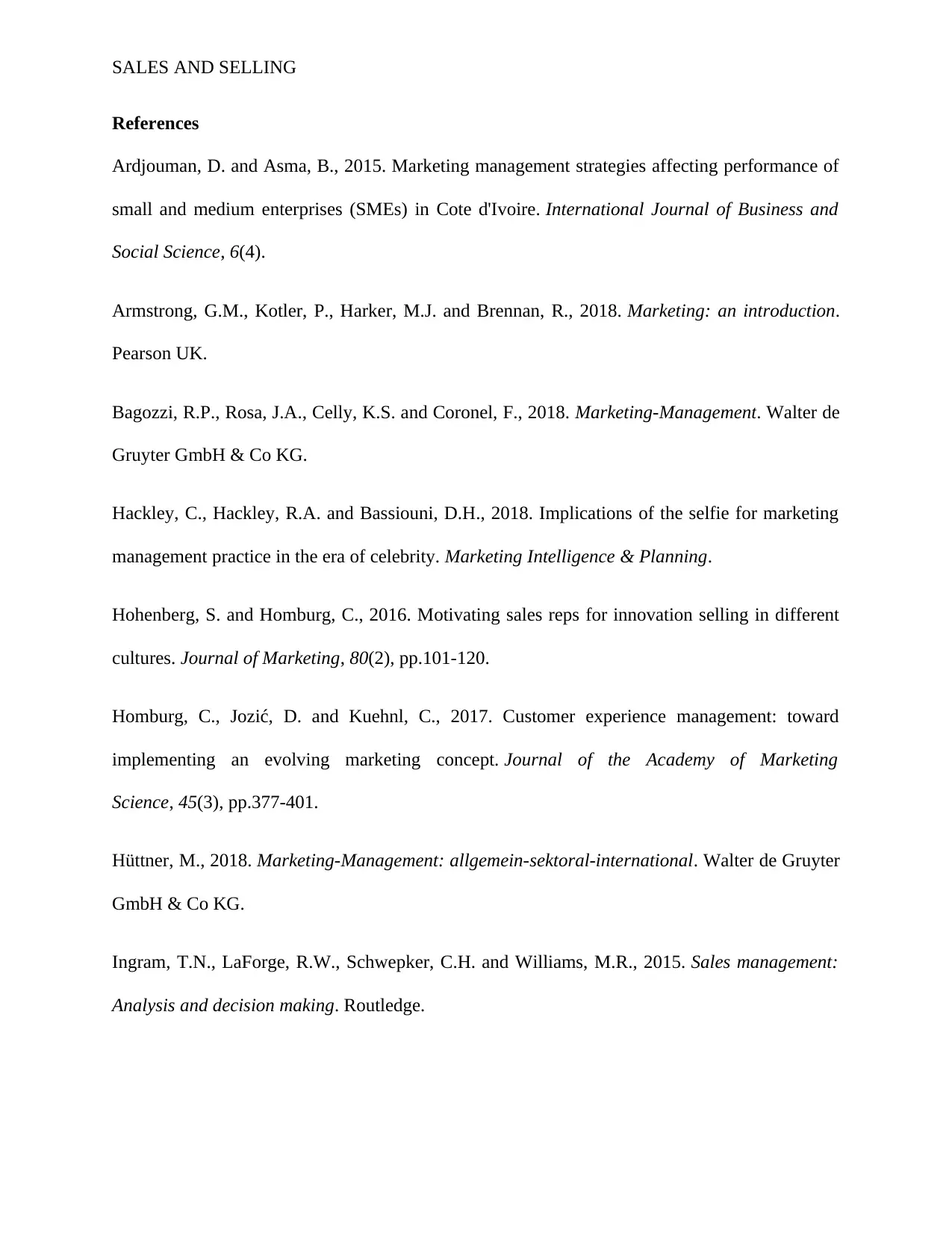
SALES AND SELLING
References
Ardjouman, D. and Asma, B., 2015. Marketing management strategies affecting performance of
small and medium enterprises (SMEs) in Cote d'Ivoire. International Journal of Business and
Social Science, 6(4).
Armstrong, G.M., Kotler, P., Harker, M.J. and Brennan, R., 2018. Marketing: an introduction.
Pearson UK.
Bagozzi, R.P., Rosa, J.A., Celly, K.S. and Coronel, F., 2018. Marketing-Management. Walter de
Gruyter GmbH & Co KG.
Hackley, C., Hackley, R.A. and Bassiouni, D.H., 2018. Implications of the selfie for marketing
management practice in the era of celebrity. Marketing Intelligence & Planning.
Hohenberg, S. and Homburg, C., 2016. Motivating sales reps for innovation selling in different
cultures. Journal of Marketing, 80(2), pp.101-120.
Homburg, C., Jozić, D. and Kuehnl, C., 2017. Customer experience management: toward
implementing an evolving marketing concept. Journal of the Academy of Marketing
Science, 45(3), pp.377-401.
Hüttner, M., 2018. Marketing-Management: allgemein-sektoral-international. Walter de Gruyter
GmbH & Co KG.
Ingram, T.N., LaForge, R.W., Schwepker, C.H. and Williams, M.R., 2015. Sales management:
Analysis and decision making. Routledge.
References
Ardjouman, D. and Asma, B., 2015. Marketing management strategies affecting performance of
small and medium enterprises (SMEs) in Cote d'Ivoire. International Journal of Business and
Social Science, 6(4).
Armstrong, G.M., Kotler, P., Harker, M.J. and Brennan, R., 2018. Marketing: an introduction.
Pearson UK.
Bagozzi, R.P., Rosa, J.A., Celly, K.S. and Coronel, F., 2018. Marketing-Management. Walter de
Gruyter GmbH & Co KG.
Hackley, C., Hackley, R.A. and Bassiouni, D.H., 2018. Implications of the selfie for marketing
management practice in the era of celebrity. Marketing Intelligence & Planning.
Hohenberg, S. and Homburg, C., 2016. Motivating sales reps for innovation selling in different
cultures. Journal of Marketing, 80(2), pp.101-120.
Homburg, C., Jozić, D. and Kuehnl, C., 2017. Customer experience management: toward
implementing an evolving marketing concept. Journal of the Academy of Marketing
Science, 45(3), pp.377-401.
Hüttner, M., 2018. Marketing-Management: allgemein-sektoral-international. Walter de Gruyter
GmbH & Co KG.
Ingram, T.N., LaForge, R.W., Schwepker, C.H. and Williams, M.R., 2015. Sales management:
Analysis and decision making. Routledge.
Secure Best Marks with AI Grader
Need help grading? Try our AI Grader for instant feedback on your assignments.
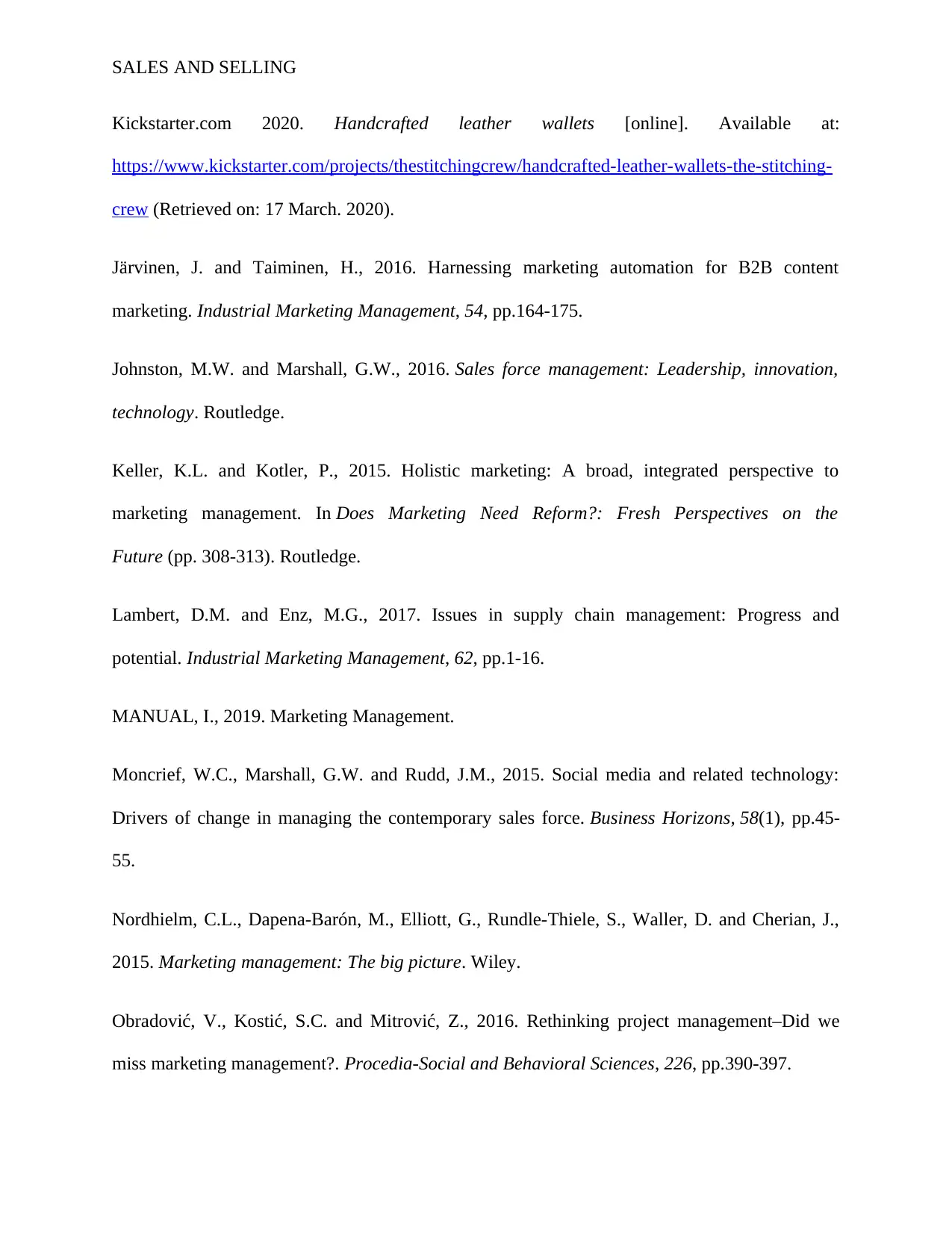
SALES AND SELLING
Kickstarter.com 2020. Handcrafted leather wallets [online]. Available at:
https://www.kickstarter.com/projects/thestitchingcrew/handcrafted-leather-wallets-the-stitching-
crew (Retrieved on: 17 March. 2020).
Järvinen, J. and Taiminen, H., 2016. Harnessing marketing automation for B2B content
marketing. Industrial Marketing Management, 54, pp.164-175.
Johnston, M.W. and Marshall, G.W., 2016. Sales force management: Leadership, innovation,
technology. Routledge.
Keller, K.L. and Kotler, P., 2015. Holistic marketing: A broad, integrated perspective to
marketing management. In Does Marketing Need Reform?: Fresh Perspectives on the
Future (pp. 308-313). Routledge.
Lambert, D.M. and Enz, M.G., 2017. Issues in supply chain management: Progress and
potential. Industrial Marketing Management, 62, pp.1-16.
MANUAL, I., 2019. Marketing Management.
Moncrief, W.C., Marshall, G.W. and Rudd, J.M., 2015. Social media and related technology:
Drivers of change in managing the contemporary sales force. Business Horizons, 58(1), pp.45-
55.
Nordhielm, C.L., Dapena-Barón, M., Elliott, G., Rundle-Thiele, S., Waller, D. and Cherian, J.,
2015. Marketing management: The big picture. Wiley.
Obradović, V., Kostić, S.C. and Mitrović, Z., 2016. Rethinking project management–Did we
miss marketing management?. Procedia-Social and Behavioral Sciences, 226, pp.390-397.
Kickstarter.com 2020. Handcrafted leather wallets [online]. Available at:
https://www.kickstarter.com/projects/thestitchingcrew/handcrafted-leather-wallets-the-stitching-
crew (Retrieved on: 17 March. 2020).
Järvinen, J. and Taiminen, H., 2016. Harnessing marketing automation for B2B content
marketing. Industrial Marketing Management, 54, pp.164-175.
Johnston, M.W. and Marshall, G.W., 2016. Sales force management: Leadership, innovation,
technology. Routledge.
Keller, K.L. and Kotler, P., 2015. Holistic marketing: A broad, integrated perspective to
marketing management. In Does Marketing Need Reform?: Fresh Perspectives on the
Future (pp. 308-313). Routledge.
Lambert, D.M. and Enz, M.G., 2017. Issues in supply chain management: Progress and
potential. Industrial Marketing Management, 62, pp.1-16.
MANUAL, I., 2019. Marketing Management.
Moncrief, W.C., Marshall, G.W. and Rudd, J.M., 2015. Social media and related technology:
Drivers of change in managing the contemporary sales force. Business Horizons, 58(1), pp.45-
55.
Nordhielm, C.L., Dapena-Barón, M., Elliott, G., Rundle-Thiele, S., Waller, D. and Cherian, J.,
2015. Marketing management: The big picture. Wiley.
Obradović, V., Kostić, S.C. and Mitrović, Z., 2016. Rethinking project management–Did we
miss marketing management?. Procedia-Social and Behavioral Sciences, 226, pp.390-397.
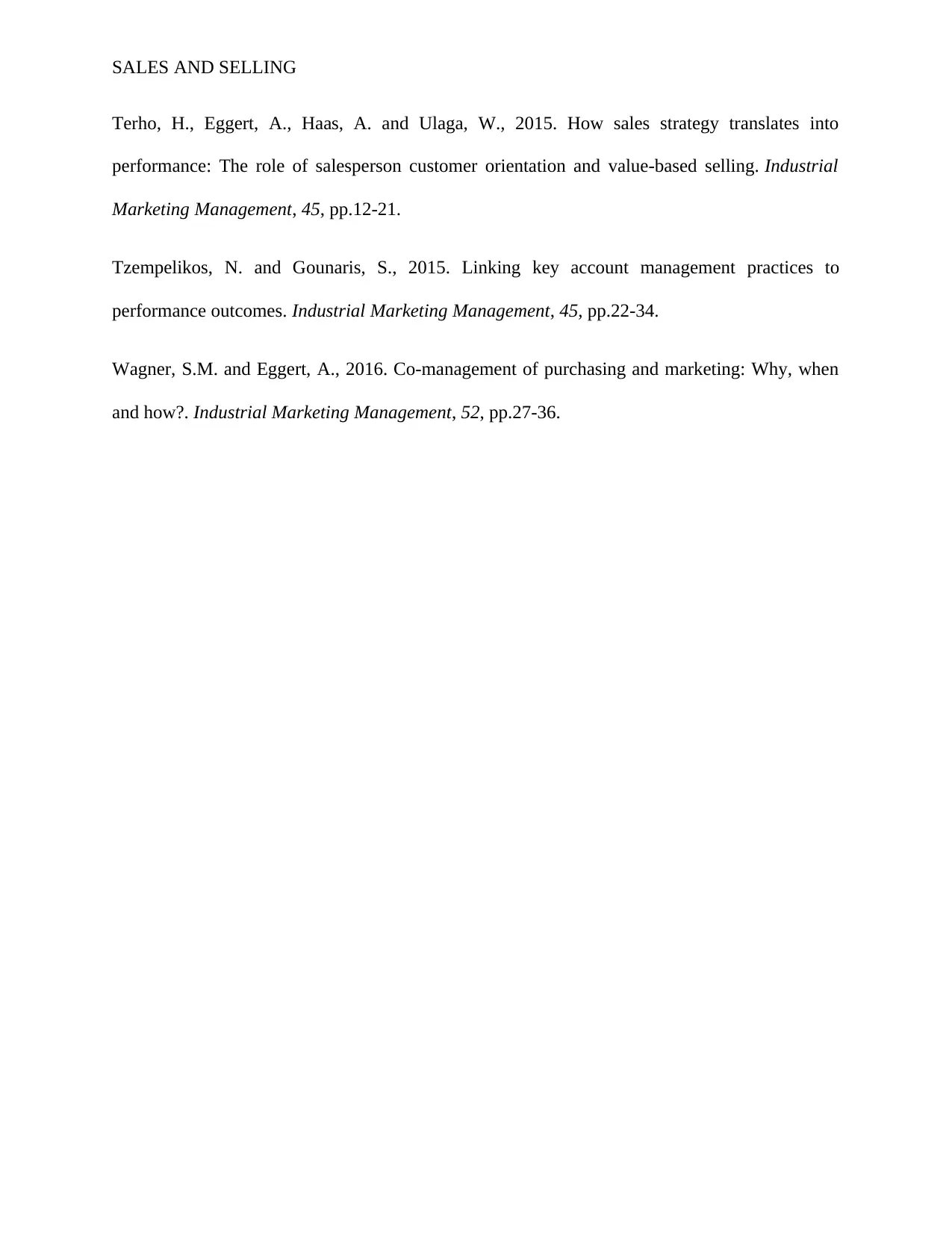
SALES AND SELLING
Terho, H., Eggert, A., Haas, A. and Ulaga, W., 2015. How sales strategy translates into
performance: The role of salesperson customer orientation and value-based selling. Industrial
Marketing Management, 45, pp.12-21.
Tzempelikos, N. and Gounaris, S., 2015. Linking key account management practices to
performance outcomes. Industrial Marketing Management, 45, pp.22-34.
Wagner, S.M. and Eggert, A., 2016. Co-management of purchasing and marketing: Why, when
and how?. Industrial Marketing Management, 52, pp.27-36.
Terho, H., Eggert, A., Haas, A. and Ulaga, W., 2015. How sales strategy translates into
performance: The role of salesperson customer orientation and value-based selling. Industrial
Marketing Management, 45, pp.12-21.
Tzempelikos, N. and Gounaris, S., 2015. Linking key account management practices to
performance outcomes. Industrial Marketing Management, 45, pp.22-34.
Wagner, S.M. and Eggert, A., 2016. Co-management of purchasing and marketing: Why, when
and how?. Industrial Marketing Management, 52, pp.27-36.
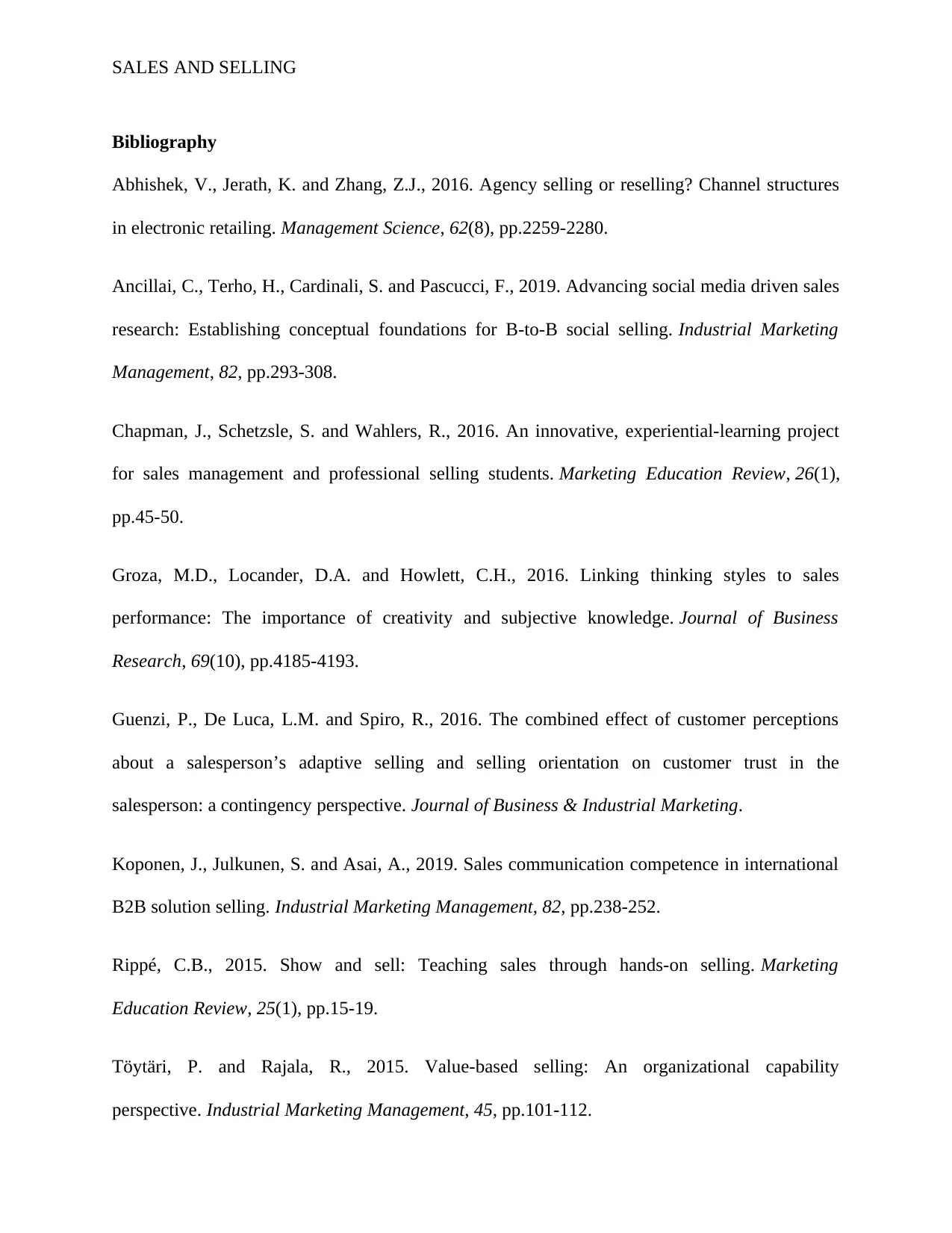
SALES AND SELLING
Bibliography
Abhishek, V., Jerath, K. and Zhang, Z.J., 2016. Agency selling or reselling? Channel structures
in electronic retailing. Management Science, 62(8), pp.2259-2280.
Ancillai, C., Terho, H., Cardinali, S. and Pascucci, F., 2019. Advancing social media driven sales
research: Establishing conceptual foundations for B-to-B social selling. Industrial Marketing
Management, 82, pp.293-308.
Chapman, J., Schetzsle, S. and Wahlers, R., 2016. An innovative, experiential-learning project
for sales management and professional selling students. Marketing Education Review, 26(1),
pp.45-50.
Groza, M.D., Locander, D.A. and Howlett, C.H., 2016. Linking thinking styles to sales
performance: The importance of creativity and subjective knowledge. Journal of Business
Research, 69(10), pp.4185-4193.
Guenzi, P., De Luca, L.M. and Spiro, R., 2016. The combined effect of customer perceptions
about a salesperson’s adaptive selling and selling orientation on customer trust in the
salesperson: a contingency perspective. Journal of Business & Industrial Marketing.
Koponen, J., Julkunen, S. and Asai, A., 2019. Sales communication competence in international
B2B solution selling. Industrial Marketing Management, 82, pp.238-252.
Rippé, C.B., 2015. Show and sell: Teaching sales through hands-on selling. Marketing
Education Review, 25(1), pp.15-19.
Töytäri, P. and Rajala, R., 2015. Value-based selling: An organizational capability
perspective. Industrial Marketing Management, 45, pp.101-112.
Bibliography
Abhishek, V., Jerath, K. and Zhang, Z.J., 2016. Agency selling or reselling? Channel structures
in electronic retailing. Management Science, 62(8), pp.2259-2280.
Ancillai, C., Terho, H., Cardinali, S. and Pascucci, F., 2019. Advancing social media driven sales
research: Establishing conceptual foundations for B-to-B social selling. Industrial Marketing
Management, 82, pp.293-308.
Chapman, J., Schetzsle, S. and Wahlers, R., 2016. An innovative, experiential-learning project
for sales management and professional selling students. Marketing Education Review, 26(1),
pp.45-50.
Groza, M.D., Locander, D.A. and Howlett, C.H., 2016. Linking thinking styles to sales
performance: The importance of creativity and subjective knowledge. Journal of Business
Research, 69(10), pp.4185-4193.
Guenzi, P., De Luca, L.M. and Spiro, R., 2016. The combined effect of customer perceptions
about a salesperson’s adaptive selling and selling orientation on customer trust in the
salesperson: a contingency perspective. Journal of Business & Industrial Marketing.
Koponen, J., Julkunen, S. and Asai, A., 2019. Sales communication competence in international
B2B solution selling. Industrial Marketing Management, 82, pp.238-252.
Rippé, C.B., 2015. Show and sell: Teaching sales through hands-on selling. Marketing
Education Review, 25(1), pp.15-19.
Töytäri, P. and Rajala, R., 2015. Value-based selling: An organizational capability
perspective. Industrial Marketing Management, 45, pp.101-112.
Paraphrase This Document
Need a fresh take? Get an instant paraphrase of this document with our AI Paraphraser

SALES AND SELLING
Yu, M., Kapuscinski, R. and Ahn, H.S., 2015. Advance selling: Effects of interdependent
consumer valuations and seller’s capacity. Management Science, 61(9), pp.2100-2117
Yu, M., Kapuscinski, R. and Ahn, H.S., 2015. Advance selling: Effects of interdependent
consumer valuations and seller’s capacity. Management Science, 61(9), pp.2100-2117
1 out of 14
Related Documents
Your All-in-One AI-Powered Toolkit for Academic Success.
+13062052269
info@desklib.com
Available 24*7 on WhatsApp / Email
![[object Object]](/_next/static/media/star-bottom.7253800d.svg)
Unlock your academic potential
© 2024 | Zucol Services PVT LTD | All rights reserved.





